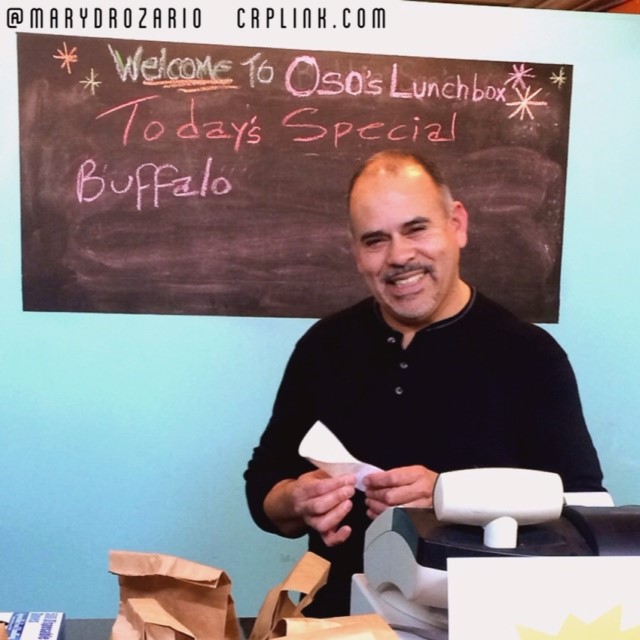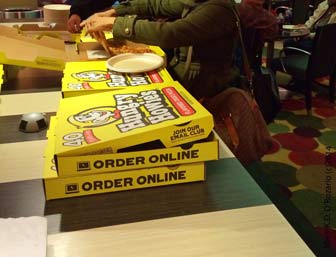RTP 180 is a TED-style monthly speaker series at The RTP Foundation. The June topic was social media, and I joined a fantastic line-up of speakers to share a five-minute message on social media.
Every presenter had an element of "build your own career" to their story. Matthew Royce of Forsythe Tech spoke on the science of what we know about effective social media strategies, Amanda Peralta of Duke spoke about channels, Chris Cohen of Bands to Fans talked about pitching Huey Lewis and the News on Social Media and filling a life-long dream, Chris Rice of Carolina Brewery spoke about All About Beers and becoming a national brand, and Justin Miller of WedPics talked about pivoting into an unexpected success.
And then there was me, doing my best to be inspirational about the possibilities that still exist in social media to make your own career, and what I think is the foundation social media skill for that route: listening. We are in a loud 50/50 country and listening is a skill that brings in opportunities. There are tons of little corners of the internet left that don't have a professional listener and companies that need that intelligence. This is more-or-less what I had to say, or you can click the YouTube link:
You are probably familiar with the barbell model of social media conversation reported by the Pew Research Foundation in February of this year. Conversations tend to group into opposing starbursts with rare connecting threads: Republican and Democrat, ACA and Obamacare, Gun Control and Gun Safety.
Curiosity drives listening. I cannot begin to emphasis enough the power of curiosity and what it means to be able to follow those connecting threads. Curiosity is a vital part of your humanity and it is important to career success, but it is essential to taking advantage of the opportunities available in social media today.
And what opportunities! More than 80% of companies say they want to expand their social media presence, but less than 8% of companies say the can readily identify the personnel they can hire as social media managers. I have used the power of curiosity to take advantage of this mismatch: Over the last few years I became an expert at watching a certain set of social media conversations. CRP now performs social media management for companies in health care and life science.
In the employment section, when I describe the ideal social media manager I ask for applicants with multicultural awareness. Multicultural tends to mean multiracial, and while that is part of it, what I really mean is that I need someone who can understand the threads linking different audiences and different conversations.
My assistant calls this speech the "get your head out of your ass" speech. When I explain how important this is people ask me, "Really? There are really people who cannot follow a conversation across different groups." Yes, really. There are people who have no idea what are the key words that sooth or set off the 50% on the other side of the fence. These people can't be allowed to speak for any company. This also explains why analytics is not the answer to every question. You have to have someone who understands the data. Larger companies are hiring "internet anthropologists." Smaller companies just need someone who is truly following the conversation.
Can you develop the skills to be a specialist in how different communities talk about the same topic? Can you be that person who can truly follow the conversation? If you can do that, just look at the people who were on the stage. There are jobs for you, there is success out there for you.
Can you be curious? People ask me about the skills of curiosity. They may not realize that is what they are asking. The question often sounds like, "How do I find who to read?"
The answer starts with observation. Anything you can do to key up your powers of observation: Write in a journal. In meetings at work talk less and write down everything. Instagram has turned everyone into a better observer: taking photographs is a powerful observation tool. Here's one, try live-drawing the plot of the next TV show you watch.
At this point in my speech Karen Kornegay tweeted a link to the work of Perrin Ireland, who is exactly the person who inspired me to start live drawing more of life. She is an artist; I live-draw just to pay closer attention.
Those 80%+ companies that are looking to expand their social media need is listening, whether they know it or not. Making noise is easy. We have more messages than the entire population could possibly listen to. If messaging continues to grow at the current rate, there will literally be more information being put out than the population can absorb. One social media manager, looking at the statistics, suggested in jest that we get people to stop brushing their teeth so there might be a few extra minutes a day to absorb messaging.
The question in social media isn’t when the tree falls, does it make a sound: in our crowded world nothing happens that someone doesn't see. But how does it affect the forest? Listening means knowing the conversation well enough that you didn't butcher that tree for naught, but that you could make an impact on the existing conversation. Bonus skills for being able to measure the impact. This is social media value, and you only get it from listening.
So it should be obvious that it drives me insane when someone wants to brag about their lack of curiosity. Probably every other successful social media manager feels the same way. You compare Christopher Columbus, who saw a blank spot on the map and risked his life and his reputation on filling in that map.
The blank spots on our maps are so easy to fill in comparison- we have the internet!
And yet I have heard business owners say, “I don’t care what other people think.” Maybe that is super brave, it's probably narcissistic, but wouldn't you be better off knowing what is on the map?
I see business owners that don't want to know anything about what one political group or another is thinking or saying. In a 50/50 country where 50% of your customers do care and care very much! I recently had a business owner who was trying to sell an expensive lifestyle product diss Kim Kardashian. Dude, you need to know exactly what Kim Kardashian does. It is now your life mission to know. It is not anything to brag about blank spots on your map except stupid.
And at the end of the day it is even worse than that. Because it's great that social media can enhance our careers or be our careers, but social media is so much more than that. It is a landscape and an architecture with the unique opportunity for people to be heard, but only if someone is there to listen.
After saying all of that there was a Q & A about totally different things. We got into some technical issues about current trends in pharma and HR. Businesses are way behind in terms of social media policies that address the realities of their regulatory responsibilities and the realities of their employees lives. Businesses are way behind in social media training, partly because of the thought that the schools and colleges might have done that and it didn't happen.
CRP provides that personnel training, as well as vision for how your employees can take advantage of the internal and external social media opportunities that intersect with their responsibilities at your company.
Meanwhile, here's the video of RTP 180. It starts with set up, the speeches start at the one hour mark:











